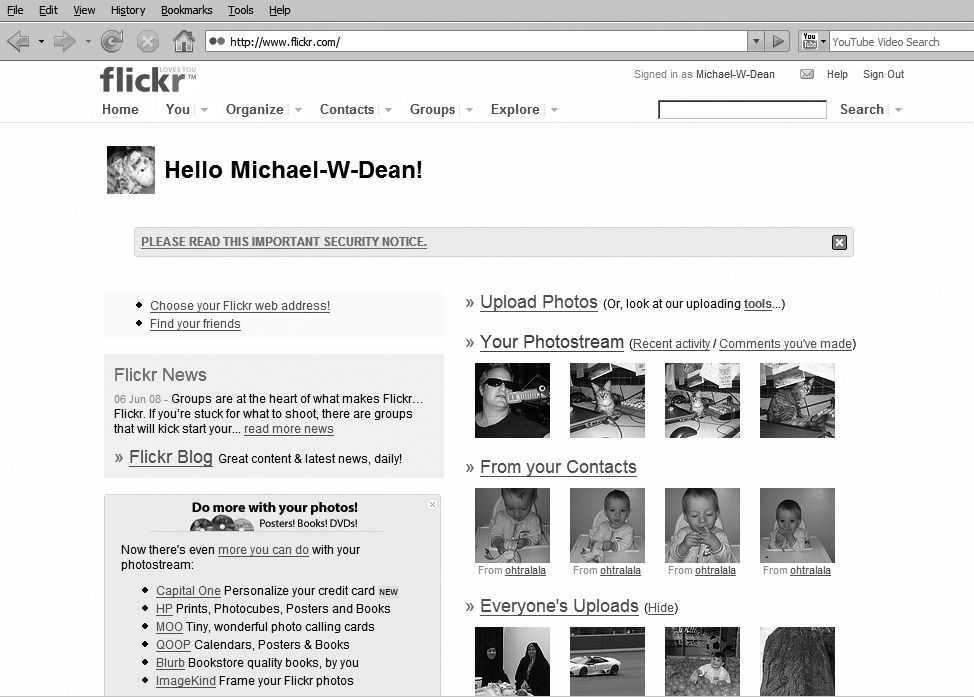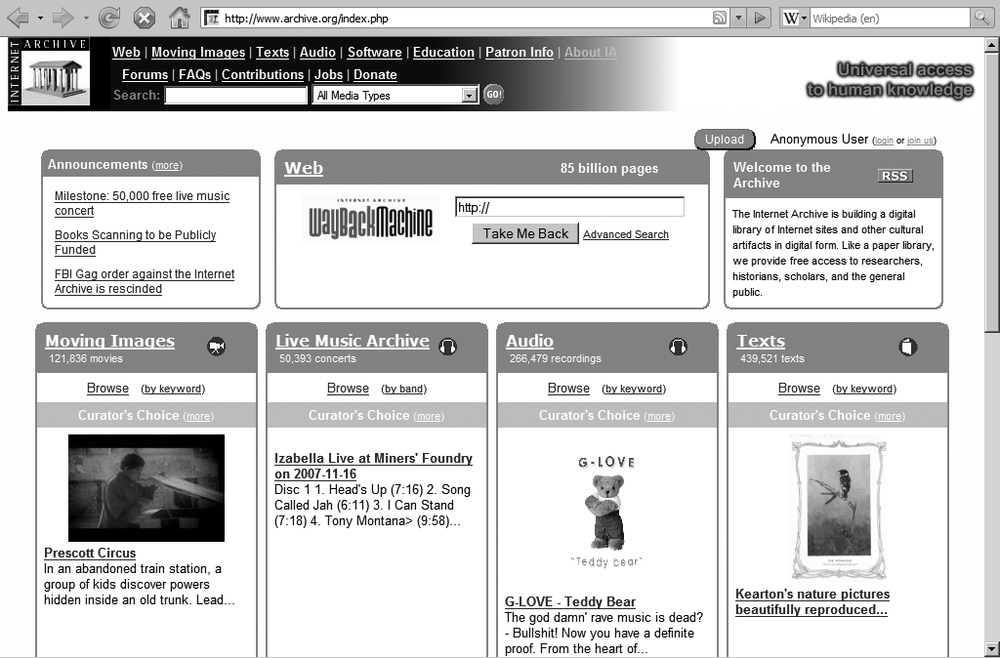Do you like the saying "Information wants to be free"? I do. So, let's look at some places to get you some free information that you can combine with your own original information to create some new information.
Creative Commons runs several sites where you can get Creative Commons content, in all media types and on all subjects. CC Audio
| http://creativecommons.org/audio (URL 6.26) |
is a great place to get Creative Commons–licensed background music, and samples for remixing, free. BlipTV is a video-specific Creative Commons site:
| http://creativecommons.org/video (URL 6.27) |
The Creative Commons–run remixing site, ccmixter.org, provides material to remix and provides a forum to upload your audio remixes; you also can use other people's remixes from that site in your work:
http://ccmixter.org/ (URL 6.28)
Flickr has millions of images and video, some of it high-rez, much of it licensed as Creative Commons, from all over the world. My friend Skip moved to a tiny town in China and I asked him to email me photos of his town. He said, "Just search the town name on Flickr. There are already hundreds of photos of it on there." Flicker is at www.flickr.com (URL 6.29). See also Figure 6-7.
You can find pretty much anything on Flickr. Just be sure to download the highest-rez version and read the license for that particular image. If you want to use the image for something not covered in the license, email the author and nicely ask permission. Make sure you keep the email of the content creator's consent as proof, if YouTube or anyone else ever needs to see it.
If you're a web programmer and want to start a site that works like Flickr or just want to know how it works, one of their hypersmart programmers, Cal Henderson, wrote a truly excellent geek book for O'Reilly called Building Scalable Web Sites: Building, Scaling, and Optimizing the Next Generation of Web Applications.
| www.amazon.com/Building-Scalable-Web-Sites-applications/dp/0596102356 (URL 6.30) |
The Podsafe Music Network is a great place to find Creative Commons music. http://music.podshow.com/ (URL 6.31)
Wikipedia lists many sources for Creative Commons audio, video, images, and text: http://tinyurl.com/5zrxvc (URL 6.32). Read the license on the media you intend to use to see what's allowed. You'll have to give attribution and provide a link to the people who created it.
Another great source of Creative Commons media is Wikipedia. Everything on Wikipedia—the text, the images, the audio, and the video—is covered by either Creative Commons, public domain, or is included as fair use.
Another great place to find material, much of it Creative Commons or in the public domain, is on this site: www.archive.org (URL 6.33) See Figure 6-8.
One section of the site in particular, the Prelinger Archive, www.archive.org/details/prelinger (URL 6.34) is a great source of downloadable, editable versions of old industrial (training) films and educational films from the 40s, 50s, and 60s. Most are in the public domain and are free to use anywhere, for any reason, even without attribution. (The Prelinger Archive is run by a very cool guy, Rick Prelinger, so go ahead and credit Archive.org if you use stuff from there.) Use that search form at the top of the page. If you're looking for videos on space travel, search for space. If you're looking for videos with John F. Kennedy, search for JFK, and so on.
Note
Just because something is called "fair use" somewhere does not mean it's fair use for you to use in a different way. Nor does being called "fair use" in a particular instance by anyone other than a judge mean it is fair use. Nor does using media in a particular situation being determined by a judge as fair use mean that you can use it as your own fair use. But if something is original and the content creator labels it as Creative Commons, then it is freely useable by anyone, as long as you follow the particular Creative Commons license that it was released under.
These (mostly black and white) gems are useful in any historical piece and are particularly asking to be used in parody and comedy pieces. (One fun place to start is finding one that "speaks" to you, or seems particularly silly to you; then write and record your own narration and add that in place of the original narration. It helps if you do the work in a vocal delivery style that mirrors the "overly professional, stilted authoritative" voice that seemed to be the standard back then.)
As always, read the licensing information on the site for each particular video, because it can vary from video to video.
Note
Because you have the right to use a particular image or piece of video, that does not give you the right to use the likeness of the person in the image or video, particularly if you seem to be falsely endorsing something that the person would not approve of or has not been paid to endorse, especially for commercial use. This is usually less of a problem in a noncommercial use, but it can still be an issue.
Also, appropriating someone's trademark in a way that incorrectly implies some sort of endorsement can likely get you into trouble, legally or with a warning, takedown, or removal of your account, even if it's in an image that was provided as Creative Commons.
Another great part of Archive.org is The Wayback Machine where you can enter any URL and see what the site looked like a few years ago. You can use it for research, or even to disprove something someone said, particularly if it was with regard to what used to be on their own website.
| www.archive.org/web/web.php (URL 6.35) |
The Wayback Machine is named after the time machine in The Rocky and Bullwinkle Show, a surreal television cartoon from when I was a kid. I loved that program so much, I have a tattoo of one the Boris Badenov characters on my chest (Figure 6-9).
| http://en.wikipedia.org/wiki/Boris_Badenov (URL 6.36) |
The political cable channel C-SPAN is a great source of political fodder for remixing and commentary videos. According to the site,
| www.c-span.org/about/copyright.asp (URL 6.37) |
C-SPAN does not restrict fair use, if the following criteria are followed:
C-SPAN permits non-commercial use of its video coverage of federal government-sponsored events so long as C-SPAN is identified during the use as the source of the video.
Keeping a "C-SPAN" logo on the screen during the use is sufficient to identify C-SPAN as the source.
This generally unrestrictive policy regarding non-commercial use does not apply to (i) original programs created by C-SPAN, (ii) video coverage of privately sponsored events, and (iii) video coverage of other events not sponsored by the federal government.
C-SPAN does not permit unlicensed commercial use of any of its video programming regardless of whether the use cites C-SPAN as the source of the video. Commercial uses of C-SPAN video may be permitted under an individually negotiated license for which a license fee may be due. [See Licensing and Permissions Requests]
Nothing in this copyright policy is intended to affect any person's right to make a "Fair Use" of C-SPAN video programming.
Basically, I don't like to risk uploading content that contains work that belongs to others, at least not uploading a whole clip by someone else. If I want to use music or video in my work, I get something by a friend who they'll let me use, make music myself, or find something on one of the sites covered in this chapter that provides hassle-free media.
As for uploading complete work by someone else, you probably don't need to do this. Most things that are out there have already been uploaded by someone, and if something hasn't been uploaded, it probably will be soon.
At least one executive at a television company has been quoted off the record as saying "If it's a popular show, we'll issue a takedown. But if it's a new show that's struggling to get an audience, we'll wait on issuing a takedown, as the free publicity will help, not hurt, at that point."
But I recommend you concentrate on uploading your own brilliance, not stuff made by other people.
So far in the first half of the book, we've covered how to get your work written, made, uploaded, set up, and viewable. And finally now we've covered our bases with copyright (or perhaps pushed a stick into a hornet's nest, depending on your viewpoint).
It is time, young Jedi, to move it out into the world and make it sing. So, "without further Apu,"[1] we move on to the next chapter, "Building Your Audience."
[1] Joke appropriated from The Simpsons as a wry cultural comment on fair use, under what I believe to be fair use.


